HTC Vive Flow review: Combining smart glasses with VR
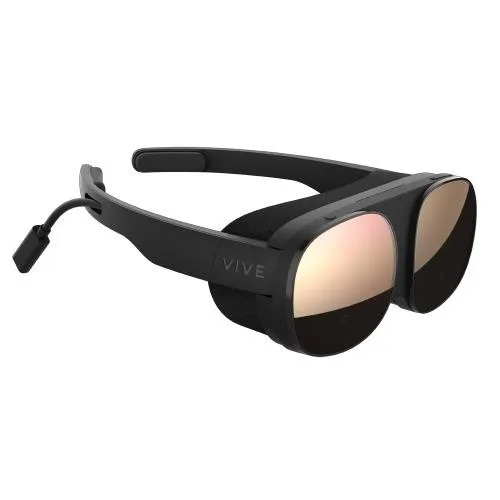
Summary
Quick verdict: While you can’t help but praise HTC for its ambition and effort in trying to bring its premium VR experience into the portable, mobile space via a smart glasses design, there’s a disconnect between its price and utility. We like it, but who will buy it?
- Solidly built with a premium feel
- Smartly designed and portable
- Genuine VR driven by your mobile
- Easy to set up and use
- Limited phone compatibility
- Comparatively expensive
- Cumbersome controls
- No in-built battery
HTC and its ever-broadening range of Vive headsets is leading the virtual reality space. While you can successfully mount arguments that the Valve Index and Meta Quest 2 offer compelling options for consumers, you can't argue with HTC's volume and breadth of VR tech. There's the premium HTC Vive Pro 2, the business focused HTC Vive Focus 3 and medium tier offerings such as the HTC Vive Cosmos Elite already in the market, amongst others.
With that in mind, the HTC Vive Flow pushes the company into yet another niche within the burgeoning VR scene. It's a device that straddles the space between a full VR headset, the budget phone VR experiences, and smart glasses such as the Facebook Ray-Ban Stories.
It's an experiment in many ways – a classic example of first-generation technology that can act as a foundation stone for things to come. But the HTC Vive Flow comes with a significant price tag. Is there enough here for early adopters to get on-board? Does it deliver enough for its price to woo the VR curious?
Let's dive into my HTC Vive Flow review.
Features
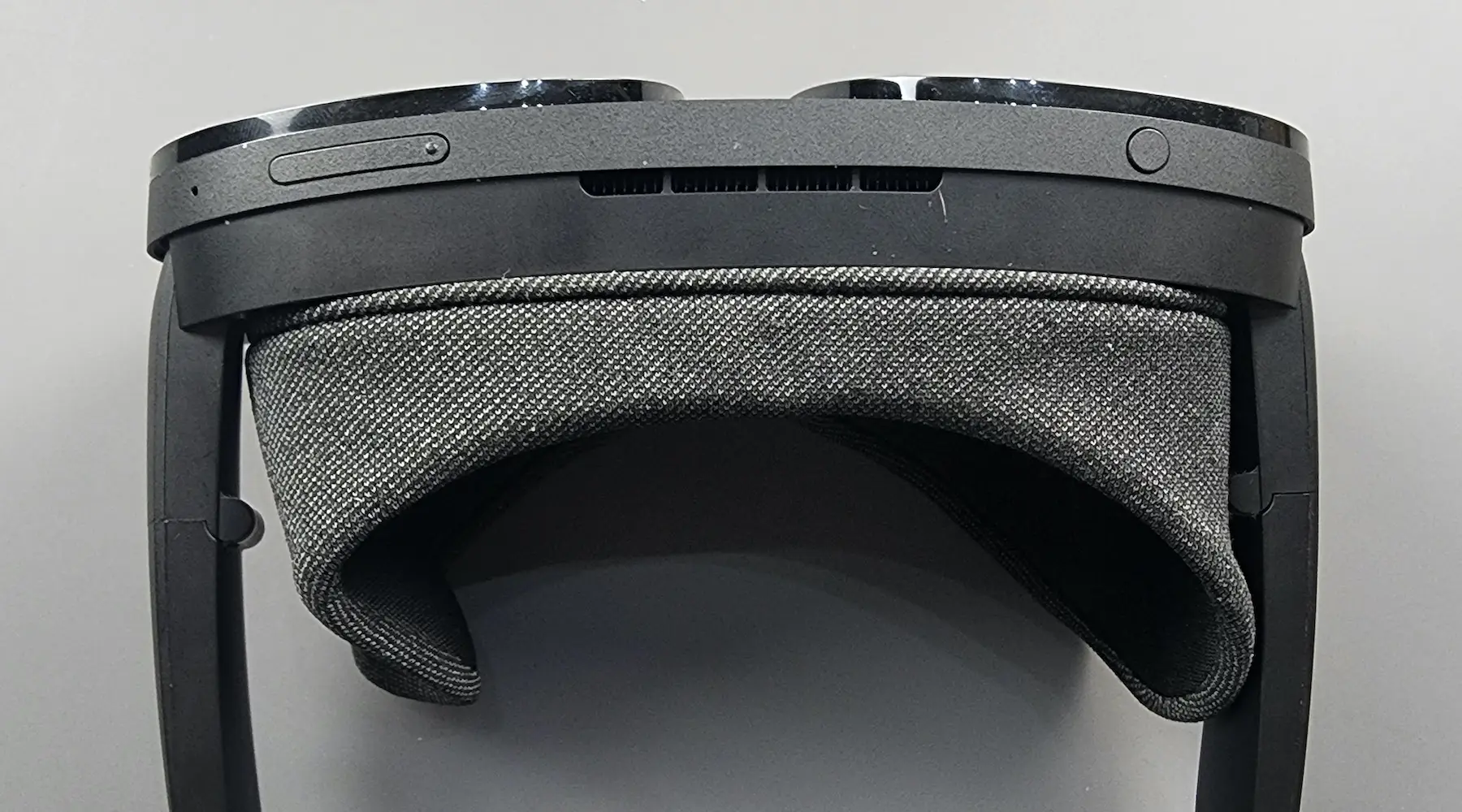
I'd call the HTC Vive Flow's specs around mid-tier. It's a fair way behind the premium offerings such as the HTC Vive Pro 2, but considering how much smaller and more portable it is, what can be found inside is relatively impressive.
The heavy lifting is done by dual 2.1-inch lenses that each offer 1600x1600 pixel resolution per eye. That's just below the Meta Quest 2, but better than the Vive Cosmos. The 75Hz refresh rate, however, is well down on modern standards.
The 100-degree field-of-view is okay on paper, but in practice I found the Vive Flow to have a larger tunnel vision effect than that figure would suggest. Thankfully there is an IPD dial of sorts. It works differently to premium headsets, allowing you to manually turn each individual lens to shift their placement and I actually found this system to work well. As my eyes have different strengths, the independent focus for each produced a clearer result that I'm accustomed to.
You'll find in-built stereo speakers with spatial audio support, which behave with a better-than-expected clarity and quality. Dual microphones with echo and noise cancellation are also fitted. However, thanks to Bluetooth 5.0 support, you can just pair a headphone solution of your own. There's no processor to worry about as your phone is your CPU, but there is a 4GB RAM boost in the device, as well as 64GB of internal storage. The latter, I suspect, reduces the demand on wireless transmission of large visual assets.
Tracking and battery
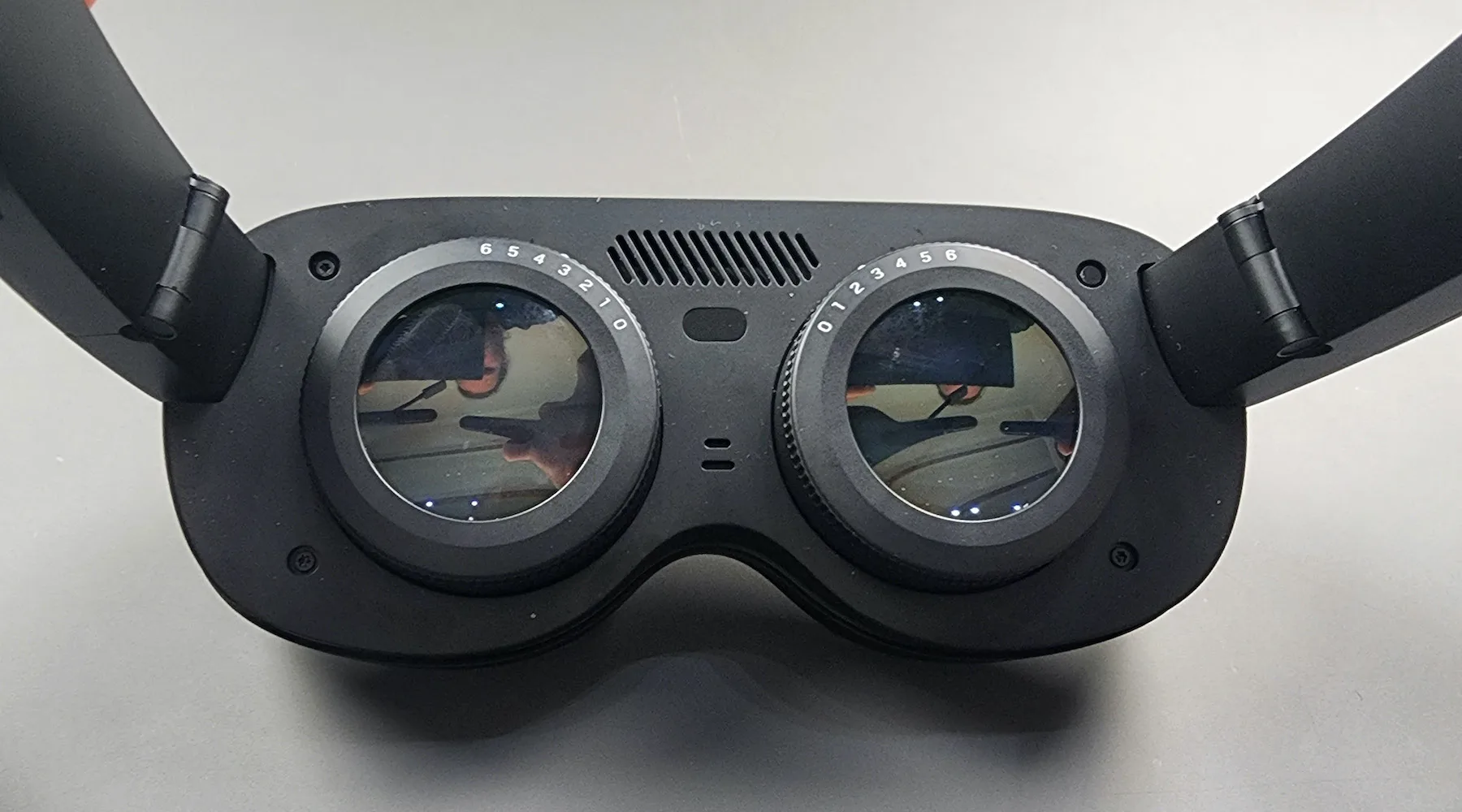
Tracking is handled by 2 inside-out cameras, which is down on the 4 we usually see with the premium VR headsets. However, I'll comment more on tracking when we talk performance, but it definitely isn't as good as it could be. Video pass-through is also possible, meaning you can switch to a real-world view without taking off the device.
The biggest drama is the lack of an in-built battery. HTC advertises no more than 5 minutes of life in the HTC Vive Flow as soon as it is unplugged. I got about 5 seconds. But really, both are laughable. As a result, you need to tether yourself – via a USB-C cable – to a power source capable of delivering at least 7.5W of power. So that could be a power point, power bank or potentially even your phone.
That said, my phone wasn't capable of delivering enough power and playing a game at the same time, and it's the brand new Samsung S22 Ultra. It worked for a while, but after 15 minutes I got a warning that the power supply wasn't good enough and it eventually shut down. I wonder if this is because the software was demanding too much of the phone. However, I was using the latest Samsung handset, so I suspect few phones will actually double as your power supply successfully.
I get there isn't an easy solution for delivering the power required to run these games and apps on a pair of smart glasses, but tethering them feels outdated out of the box. It also requires you to think about getting a long USB-C cable, or purchasing a power bank (and a long cable) that you can put in your pocket.
That's more expense.
Design
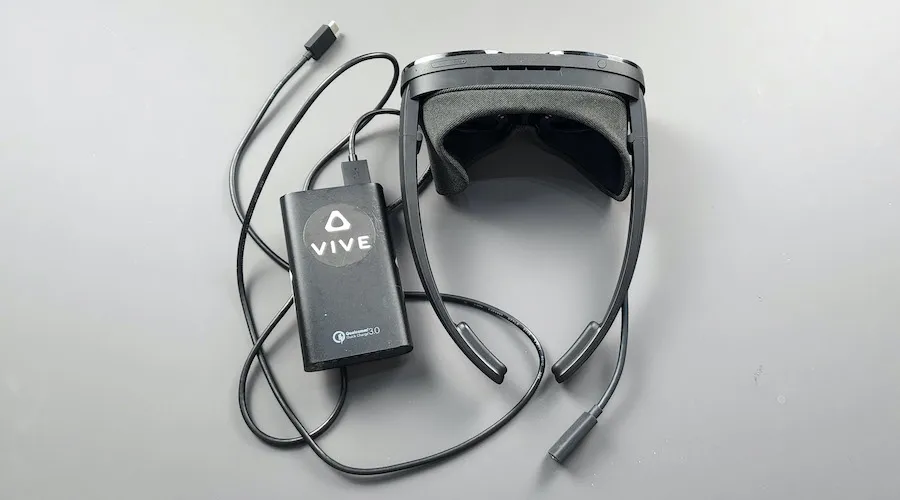
Image: Chris Stead/Finder
There's no missing the HTC Vive Flow. It's rather odd looking, as if modelled on the giant eyes of a fly. Yet it has this reflective, 80s aviator-style sunglass finish to it as well. I'm sure some of you will differ in opinion, but I think they look pretty futuristic and cool, aided by the no-nonsense black matt chassis.
The iconic look gives the impression of a device that is bulky and heavy, but that's not the case. At 189 grams, there's not too much to it. And while it's substantially thicker than a traditional pair of sunglasses, I actually think HTC has done an amazing job getting a VR headset – albeit sans battery – into a form factor that sits snugly on your face and folds up neatly for storage.
Indeed, with the arms bent inwards, the HTC Vive Flow is as wide and long as my phone, and perhaps 2.5 inches deep. A volume and an action button sit on top where they can be easily accessed. The speakers and mics are incredibly discrete, and even the power cable comes through the arm in such a way as to not feel like a weird alien attachment.
The soft, flexible gasket feels like it's made of wetsuit, and is easily removed thanks to its magnetic connection. It creates an okay seal, but there is definitely light bleed creeping in around the nose. There is a foam pad at the end of the arms, which have a tight grip that clasps to your skull just past the temples, holding the Flow in place.
Is the HTC Vive Flow comfortable?
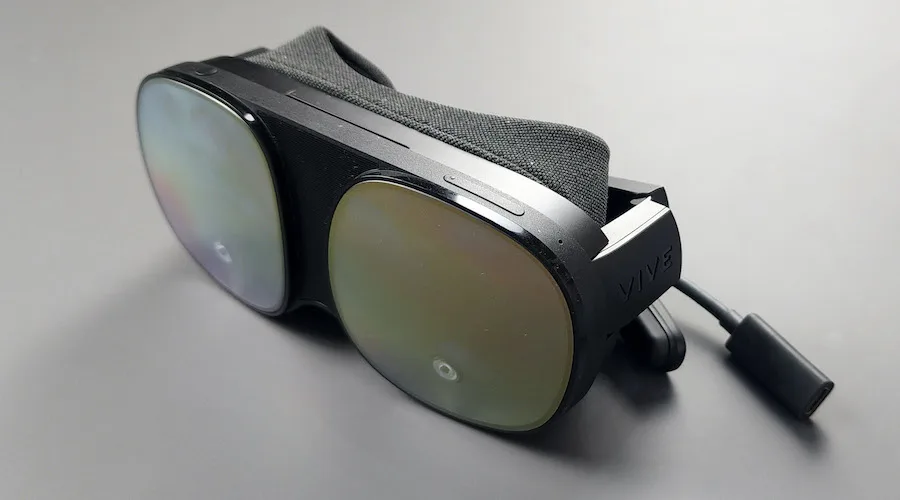
Image: Chris Stead/Finder
This system works for the most part, although the lack of a counterbalance at the back does mean the Flow puts a bit of pressure on your nose during long plays. I wouldn't go as far as to say it hurts, but it's not a contraption you'd call comfortable. You definitely know you've been wearing the Flow.
The lack of an external dial to adjust the lens is a bit of a bummer. Instead, you need to try and get your finger down in front of your eyes so you can adjust the lenses manually to get the right focus. You really only have to do this once, however. And as mentioned, I was really pleased with how clear I could get the focus point on the flow.
Connecting and phone compatibility

Image: Chris Stead/Finder
Anyone who has spent time in the premium VR space will know that set-up can be a real pain. This holds particularly true of the HTC Vive Pro 2. The HTC Vive Flow isn't nearly as cumbersome, but I wouldn't call it straightforward.
The first issue you'll face is phone compatibility. At the time of writing, iOS isn't viable at all, so if you've got an Apple device then you're well out of luck. But not all Android devices are compatible, either. This list is the one you need to check, with around 80 handsets currently considered fully compatible.
This does include most recent phones, but even with the latest handset I was compelled to do a lengthy phone update, followed by an even longer update of the Flow headset itself on initial set-up. You'll also need to fiddle with some settings on your phone regarding app permissions, set up a Viveport account and get everything pairing correctly. Note, you also need a router offering Wi-Fi on the 5GHz channel.
HTC has done a solid job of walking you through this via the Vive app. That said, it was still a good 45 minutes before I was actually able to use the thing.
Smaller phones better
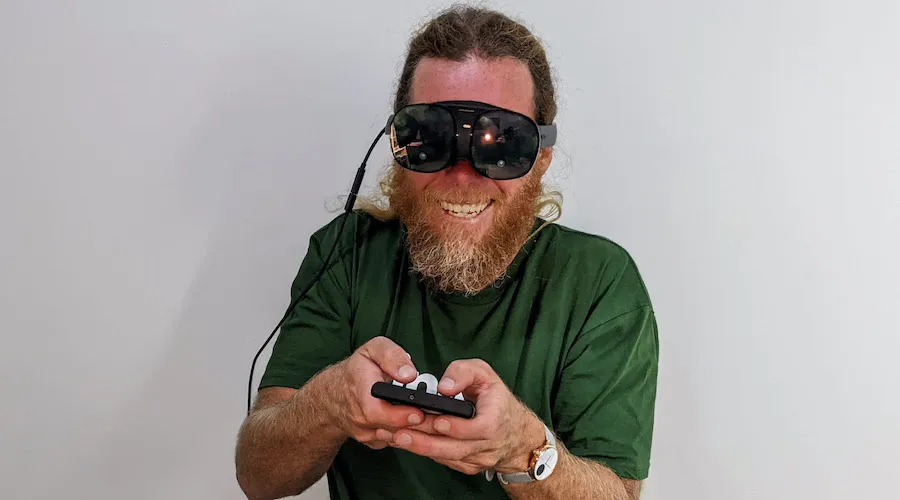
Image: Chris Stead/Finder
On the topic of phones, it's worth noting that the smaller the screen, the better. It's your phone that doubles as your controller. As mentioned, I was using the new Samsung S22 Ultra for this review, which has a large 6.8-inch screen. The screen is broken into 4 quadrants by the Vive app, each of which when pressed interacts with the software in a different way.
Problem is, with one hand on a large screen, you can't access all 4 spots. For me, that meant playing with 2 hands, my arms squished against my body like chicken wings. This is why I recommend a smaller phone screen. But really, you should be able to customise the screen real estate that functions as a controller so you can play the way you want on any screen size.
HTC Vive Flow apps
The HTC Vive Flow leans on Viveport for its content. There's a diverse library of experiences to enjoy, which includes educational, social, telecommunication, business and health apps, but is dominated by games. I wouldn't go as far as to call it a big library, but you'll certainly find plenty to do. And the storefront is available within the interface itself.
More importantly, the experiences don't feel like an approximation of VR as we've seen with some other phone-reliant VR headsets – in particular, cheapies like the VR Box 2.0. It does feel like genuine VR. And the reliance on Viveport, as opposed to the likes of the Google Play store, ensures a higher quality of experience. You may not like every VR app, but at least they work!
Since you need to tether your Vive Flow anyway, I would have liked to have seen it connect with PC experiences as well. This could have given some added utility to the device, and not only opened it up to all the PC-focused VR experiences on Viveport, but Steam as well. Perhaps it comes down to the way the device uses the phone as the controller, but I suspect that is a feature we may see in a Vive Flow 2 one day.
Performance

Image: Chris Stead/Finder
As mentioned, the good news is that on the HTC Vive Flow, you do get a genuine VR experience. It's not a taste of VR, you're immersed in full worlds and content you can freely explore. And Viveport being a VR-specific portal, they aren't plagued by the same bugs we see in more generic VR experiences on mobile app stores and places like YouTube.
I thought the sound quality wasn't too bad for in-built audio, giving you a spatial awareness by changing believably as you move your head about. And while the visual specs aren't up to the premium standard, it's only really noticeable on realistic content. For example, GoPro vids and travel content look low-res. But on games with cartoony or fantasy visuals, it looks fine.
I wasn't getting a screen door effect, although I felt the field-of-view was compromised. There's a decent tunnel effect – also known as periscope view, more so than I would have expected given the advertised 100-degree FOV.
It's not the quality of the content that I found issue with, but instead the tracking and controller. First off, you need a brightly lit area to play in. In the dark, I found that the play space kept drifting and I couldn't look around freely without the screen going black. In a lit environment, the head tracking works fine, but you suffer light bleed.
Controller woes
Using the phone as a controller can also be tedious and frustrating. The headset tracks the movement of your device, but only in a 2D plane. The phone, as it appears in an app, doesn't move away from you if you reach out with it in your hands. As a result, it's always cramped up close to you. As your virtual phone often provides instructions on how to interact with the app, you end up struggling to see and read it. It's almost always out of your view.
I also found the buttons frequently didn't work when pressed, or needed precise pressing of a particular spot on a big screen. A number of times I was just pressing the screen all over trying to get it to do something. You've got to wonder why they just didn't include a basic controller with purpose-built buttons. The frustration isn't a deal-breaker, but a phone just isn't the ideal controller.
Other frustrations include phone notifications coming through in the middle of heated combat, darkening the screen so you can't see what's going on in the gameplay. Even when you've turned notifications off! And a few times I had to reset the entire headset just to get the notifications to disappear.
Should you buy the HTC Vive Flow?
At the top, I referenced the HTC Vive Flow as being first-generation tech. If looked at through this lens and in isolation, the Flow is impressive. As an attempt to bring a premium VR experience to smart glasses, you can't help but take your hat off to the company. The Flow is well made, smartly designed and turns your phone into a conduit for genuine and portable virtual reality.
Yet it has shortcomings and they're the kind you can see being eradicated in future revisions. The lack of an in-built battery, the restricted field-of-view and refresh rate, and light bleed around the gasket's nose lead the list. But also, the responsiveness and tracking issues that come with doubling your phone as your controller.
You've got to start somewhere though. And while I'm happy to praise HTC for what it's achieved with the Vive Flow, ultimately, who is it for? The fact that the VR curious can pay less to pick up the full VR offering with the Meta Quest 2 can't be ignored. And the limited library, lacklustre controller and reduced specs compared to the likes of the HTC Vive Pro 2 may not be enough for tech aficionados.
I fear that the Vive Flow may not find an audience, although in time it may well be seen as a critical stepping stone to a more portable and user-friendly VR future.
Price and availability
The HTC Vive Flow is available now in Australia, which wasn't a given ahead of launch. Many of the VR headsets circulating in overseas markets can't be acquired easily in Australia, so kudos to HTC for including Down Under. But it comes at a cost. The HTC Vive Flow retails for $749, and I haven't seen it budge below that price online.
That's a challenging investment for this technology. You can pick up a Meta Quest 2 (AKA Oculus Quest 2) for under $500, while the Ray-Ban Stories goes for around $450. You can get a Cosmos Elite headset for $799, too, although you'll need to get Base Stations and Vive controllers to use it if you don't have them already.
On the positive side, as long as you have a compatible phone, you don't need to invest in a high-powered PC to run the HTC Vive Flow.
